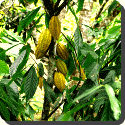 Cacao — Cacao (Theobroma cacao) is a small (4-8 m tall (15-26 ft)) evergreen tree in the family Sterculiaceae (alternatively Malvaceae), native to the deep tropical region of the Americas. There are two prominent competing theories about the origins of the original wild Theobroma cacao tree. One group of proponents believe wild examples were originally distributed from southeastern Mexico to the Amazon basin, with domestication taking place both in the Lacandon area of Mesoamerica and in lowland South America. Recent studies of Theobroma cacao genetics seem to show that the plant originated in the Amazon and was distributed by man throughout Central America and Mesoamerica. Its seeds are used to make cocoa and chocolate.
Cacao — Cacao (Theobroma cacao) is a small (4-8 m tall (15-26 ft)) evergreen tree in the family Sterculiaceae (alternatively Malvaceae), native to the deep tropical region of the Americas. There are two prominent competing theories about the origins of the original wild Theobroma cacao tree. One group of proponents believe wild examples were originally distributed from southeastern Mexico to the Amazon basin, with domestication taking place both in the Lacandon area of Mesoamerica and in lowland South America. Recent studies of Theobroma cacao genetics seem to show that the plant originated in the Amazon and was distributed by man throughout Central America and Mesoamerica. Its seeds are used to make cocoa and chocolate.
The tree is today found growing wild in the low foothills of the Andes at elevations of around 200-400 m (650-1300 ft) in the Amazon and Orinoco river basins. It requires a humid climate with regular rainfall and good soil. It is an understory tree, growing best with some overhead shade. The leaves are alternate, entire, unlobed, 10-40 cm (4-16 in) long and 5-20 cm (2-8 in) broad.
The flowers are produced in clusters directly on the trunk and older branches; they are small, 1-2 cm (1/2-1 in) diameter, with pink calyx. While many of the world’s flowers are pollinated by bees (Hymenoptera) or butterflies/moths (Lepidoptera), cacao flowers are pollinated by tiny flies, midges in the order Diptera. The fruit, called a cacao pod, is ovoid, 15–30 cm (6-12 in) long and 8-10 cm (3-4 in) wide, ripening yellow to orange, and weighs about 500 g (1 lb) when ripe. The pod contains 20 to 60 seeds, usually called “beans”, embedded in a white pulp. Each seed contains a significant amount of fat (40-50% as cocoa butter). Their most noted active constituent is theobromine, a compound similar to caffeine.
 Kids Portal For Parents India Kids Network
Kids Portal For Parents India Kids Network






